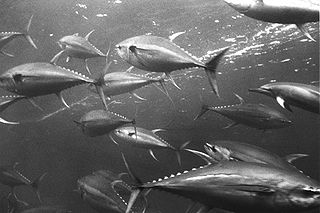
The mackerel, tuna, and bonito family, Scombridae, includes many of the most important and familiar food fishes. The family consists of 51 species in 15 genera and two subfamilies. All species are in the subfamily Scombrinae, except the butterfly kingfish, which is the sole member of subfamily Gasterochismatinae.

Marine hatchetfishes or deep-sea hatchetfishes are small deep-sea mesopelagic ray-finned fish of the stomiiform subfamily Sternoptychinae. They should not be confused with the freshwater hatchetfishes, which are not particularly closely related Teleostei in the characiform family Gasteropelecidae.

Goosefishes, sometimes called anglers or monkfishes, are a family, the Lophiidae, of marine ray-finned fishes belonging to the order Lophiiformes, the anglerfishes. The family includes 30 recognized species. These fishes are found in all the world's oceans except for the Antarctic Ocean.

The marine hatchetfishes or deep-sea hatchetfishes as well as the related bottlelights, pearlsides and constellationfishes are small deep-sea ray-finned fish of the stomiiform family Sternoptychidae. They are not closely related to and should not be confused with the freshwater hatchetfishes, which are teleosts in the characiform family Gasteropelecidae. The Sternoptychidae have 10 genera and about 70 species altogether.

The Molidae comprise the family of the molas or ocean sunfishes, unusual fish whose bodies come to an end just behind the dorsal and anal fins, giving them a "half-fish" appearance. They are also the largest of the ray-finned bony fish, with the southern sunfish, Mola alexandrini, recorded at 4.6 m (15 ft) in length and 2,744 kg (6,049 lb) in weight.

The Moronidae is a family of percomorph fishes, commonly called the temperate basses, in the order Moroniformes. These fishes are found in the freshwaters of North America and the coastal waters of the North Atlantic.

The Gempylidae are a family of perciform fishes commonly known as snake mackerels or escolars. The family includes about 25 species.
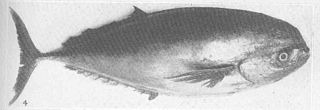
The louvar or luvar is a species of marine ray-finned fish, it is the only extant species in the genus Luvarus and family Luvaridae. This taxon is classified within the suborder Acanthuroidei, which includes the surgeonfish, of the order Acanthuriformes, and is the only pelagic species of this order. The juvenile form has a pair of spines near the base of the tail, like the surgeonfish, though they are lost in the adult.

Codlets are a family, Bregmacerotidae, of cod-like fishes, containing the single genus Bregmaceros found in tropical and subtropical waters throughout the world. They are very small fishes and even the largest, B. lanceolatus, reaches only 11.5 cm (4.5 in) in length.

Crestfishes, family Lophotidae, are lampriform fishes found in most oceans. It consists of two extant and four extinct genera.

Frogfishes are any member of the anglerfish family Antennariidae, of the order Lophiiformes. Antennariids are known as anglerfish in Australia, where the term "frogfish" refers to members of the unrelated family Batrachoididae. Frogfishes are found in almost all tropical and subtropical oceans and seas around the world, the primary exception being the Mediterranean Sea.

Carcharias is a genus of mackerel sharks belonging to the family Odontaspididae. Once bearing many prehistoric species, all have gone extinct with the exception of the critically endangered sand tiger shark.

Priscacara, is a genus of extinct temperate bass described from Early to Middle Eocene fossils. It is characterized by a sunfish-like body and its stout dorsal and anal spines. The genus is best known from the Green River Formation of Wyoming, Utah and Colorado. Mass deaths of Priscacara suggest it formed schools.
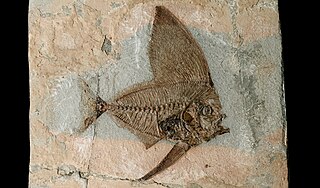
Exellia is a genus of extinct spadefish that lived in the Tethys Ocean during the early Paleogene. The adult form is shaped akin to a large spadefish or a short dolphinfish, with very large pelvic fins, and a long dorsal fin starting from in front of the eyes to near the base of the caudal peduncle. The juvenile form resembles a juvenile drumfish, with the dorsal fin forming a long crest on top of the head.

Caranx is a genus of tropical to subtropical marine fishes in the jack family Carangidae, commonly known as jacks, trevallies and kingfishes. They are moderate- to large-sized, deep-bodied fishes which are distinguished from other carangid genera by specific gill raker, fin ray and dentition characteristics. The genus is represented in the Pacific, Indian and Atlantic Oceans, inhabiting both inshore and offshore regions, ranging from estuaries and bays to deep reefs and offshore islands. All species are powerful predators, taking a variety of fish, crustaceans and cephalopods, while they in turn are prey to larger pelagic fishes and sharks. A number of fish in the genus have a reputation as powerful gamefish and are highly sought by anglers. They often make up high amounts of the catch in various fisheries, but are generally considered poor to fair table fishes.

Eumecichthys fiski, the unicorn crestfish or unicornfish, is a very rare, little-known species of crestfish in the family Lophotidae, and the only member of the genus Eumecichthys. It likely has a worldwide distribution, having been first discovered offshore of Kalk Bay, South Africa, and subsequently reported from the Sea of Japan, southwest Florida, Clarion Island off Mexico, Hawaii, and India. A report from the Bering Sea may have been in error. It is found in the bathypelagic zone, at a depth of around 1,000 m (3,300 ft).

Phareodus is a genus of freshwater fish from the Paleocene to the Eocene of Australia, Europe and North and South America.
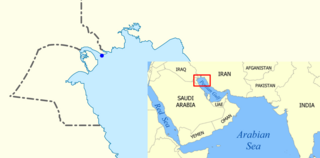
The pita skate is a medium-sized skate in the family Rajidae. The holotype and only known specimen was found in the northern Persian Gulf, in Iraqi waters. It was collected at a depth of less than 15 m (49 ft).

Liopropoma santi, the spot-tail golden bass, is a species of marine ray-finned fish, related to the groupers and classified within the subfamily Epinephelinae of the family Serranidae. It has been collected from deep reefs off Curaçao, southern Caribbean; it is the deepest occurring Liopropoma species in the Atlantic Ocean.
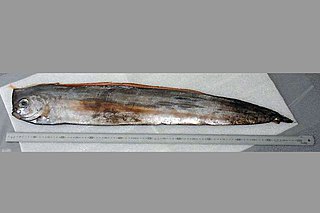
The crested bandfish is a species of crestfish in the family Lophotidae. It has a long string-like body, with large eyes, a red dorsal fin, elongated leading rays, and a short anal fin near the caudal fin. It grows up to 2 metres in length.





















